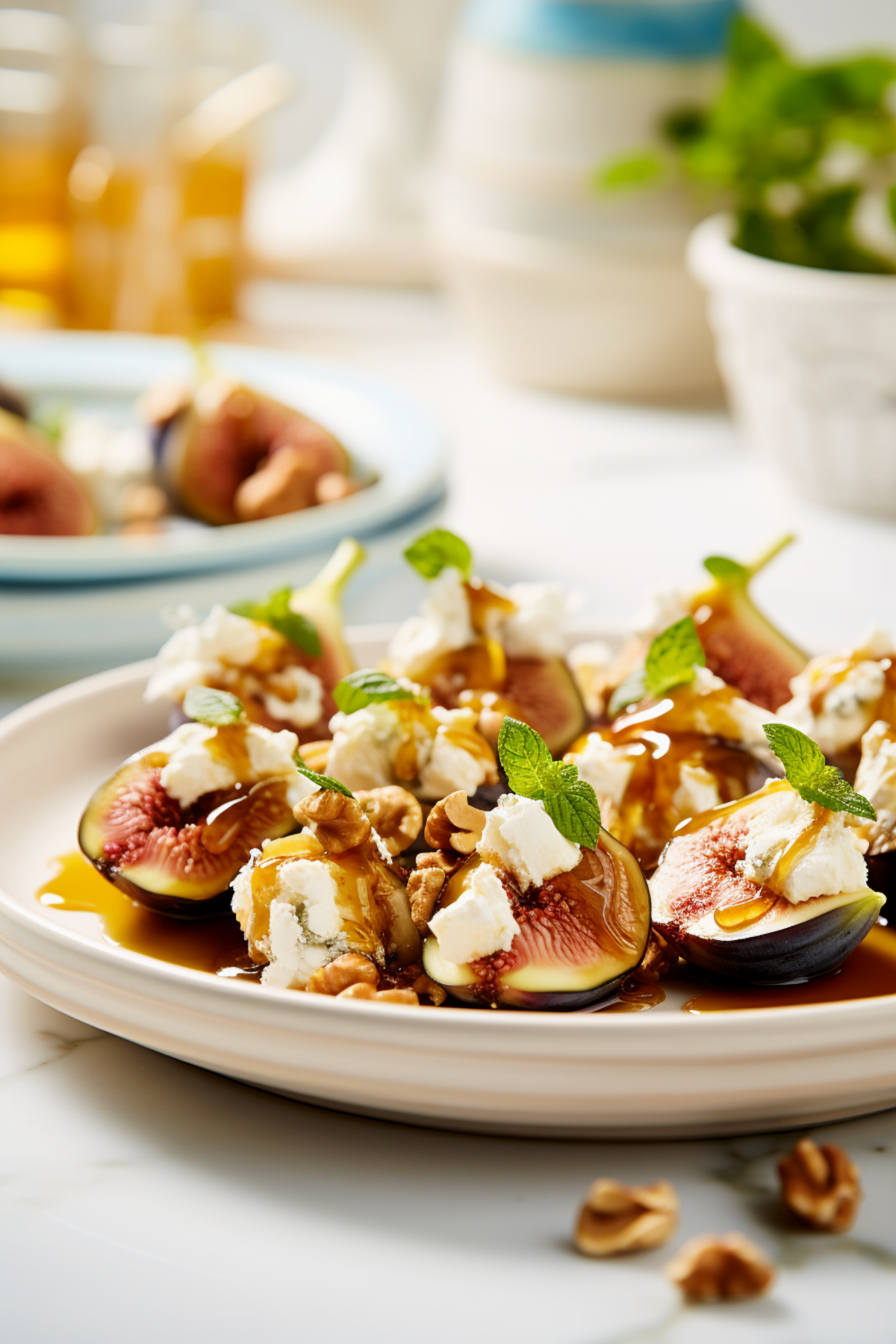Indulge in a Taste of Turkey: Baked Figs with Honey and Clotted Cream (Kaymak)
Imagine the warmth of a Turkish kitchen, the sweet aroma of honey, and the rich texture of clotted cream. This is what awaits you with our Turkish-Style Baked Figs with Honey and Clotted Cream (Kaymak). A dessert that’s as simple as it is luxurious, it combines the natural sweetness of ripe figs with the decadent touch of honey and the creamy embrace of kaymak. Perfect for a sophisticated finale to your meal or a sumptuous treat to enjoy with tea, this recipe is a testament to the simple elegance of Mediterranean desserts.
Whether you’re new to Turkish cuisine or a seasoned connoisseur, this dish will transport you straight to the bustling streets of Istanbul, where such sweet delights are savored. Read on to discover how to bring this traditional Turkish indulgence to your own table.
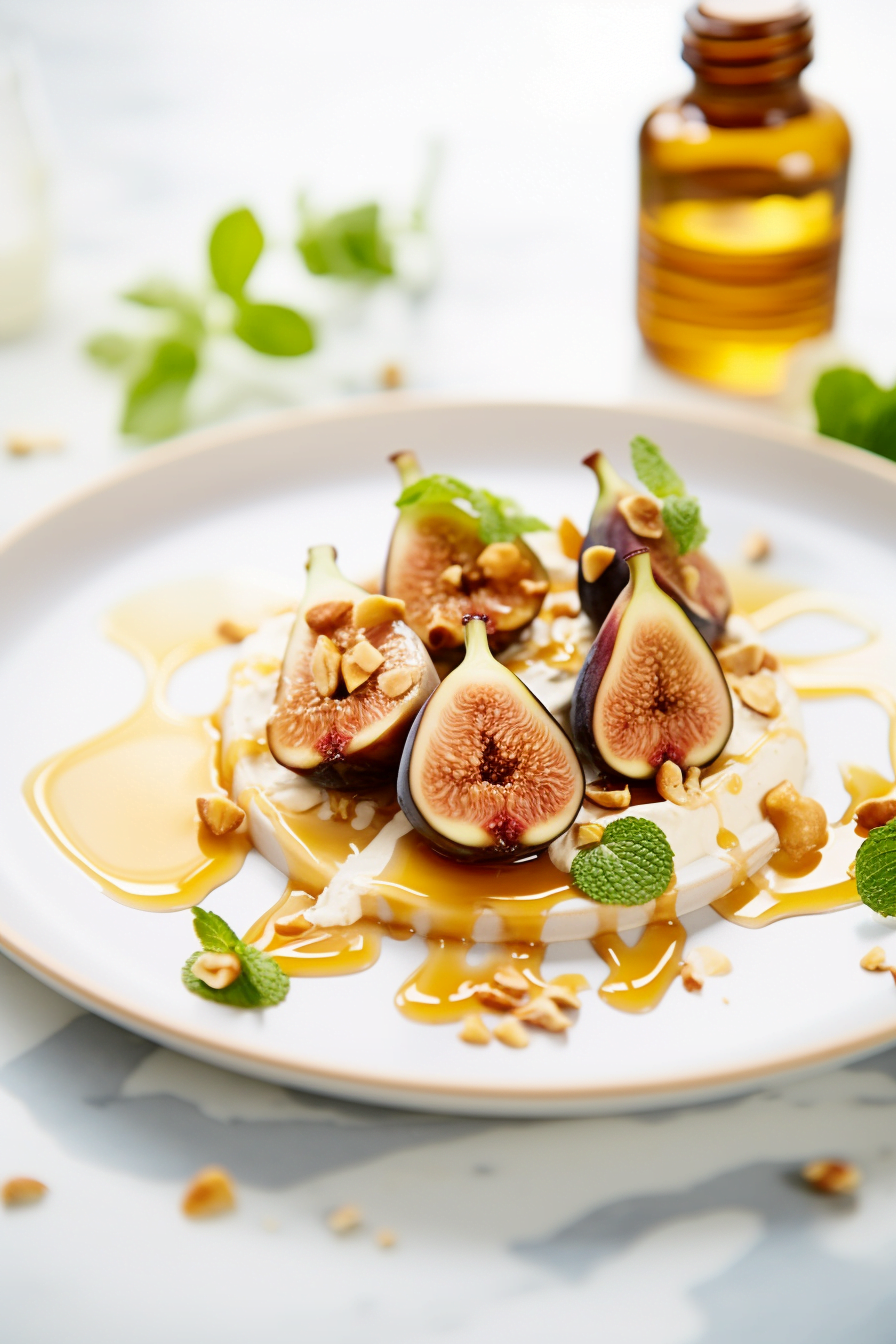
The Story Behind Turkish Baked Figs
Our journey begins in the vibrant markets of Turkey, where the scent of spices mingles with the sweet fragrance of fresh fruits. Among these, the fig holds a place of honor, celebrated for both its taste and its nutritional value. Turkish-Style Baked Figs with Honey and Clotted Cream (Kaymak) is a dish steeped in this rich heritage, a dessert that has graced Turkish tables for generations.
In Turkey, figs are not just a fruit; they are a symbol of abundance and fertility. The process of baking figs brings out their natural sugars, creating a caramelized exterior that contrasts beautifully with the soft, juicy interior. Drizzling honey over the figs is a nod to the ancient Anatolian tradition of beekeeping, while the addition of kaymak, a thick clotted cream, introduces a luxurious creaminess that is truly Turkish.
This dessert encapsulates the essence of Turkish hospitality, where sharing a meal is an act of friendship and warmth. It’s common to find this dish served during special occasions and family gatherings, often accompanied by a strong Turkish tea or coffee. The simplicity of the ingredients belies the complexity of flavors, making it a beloved treat for both locals and visitors alike.
As you prepare to recreate this recipe, you’re not just making a dessert; you’re weaving together strands of history, culture, and culinary artistry. Each bite is a celebration of the Mediterranean’s bountiful produce and Turkey’s rich gastronomic traditions.
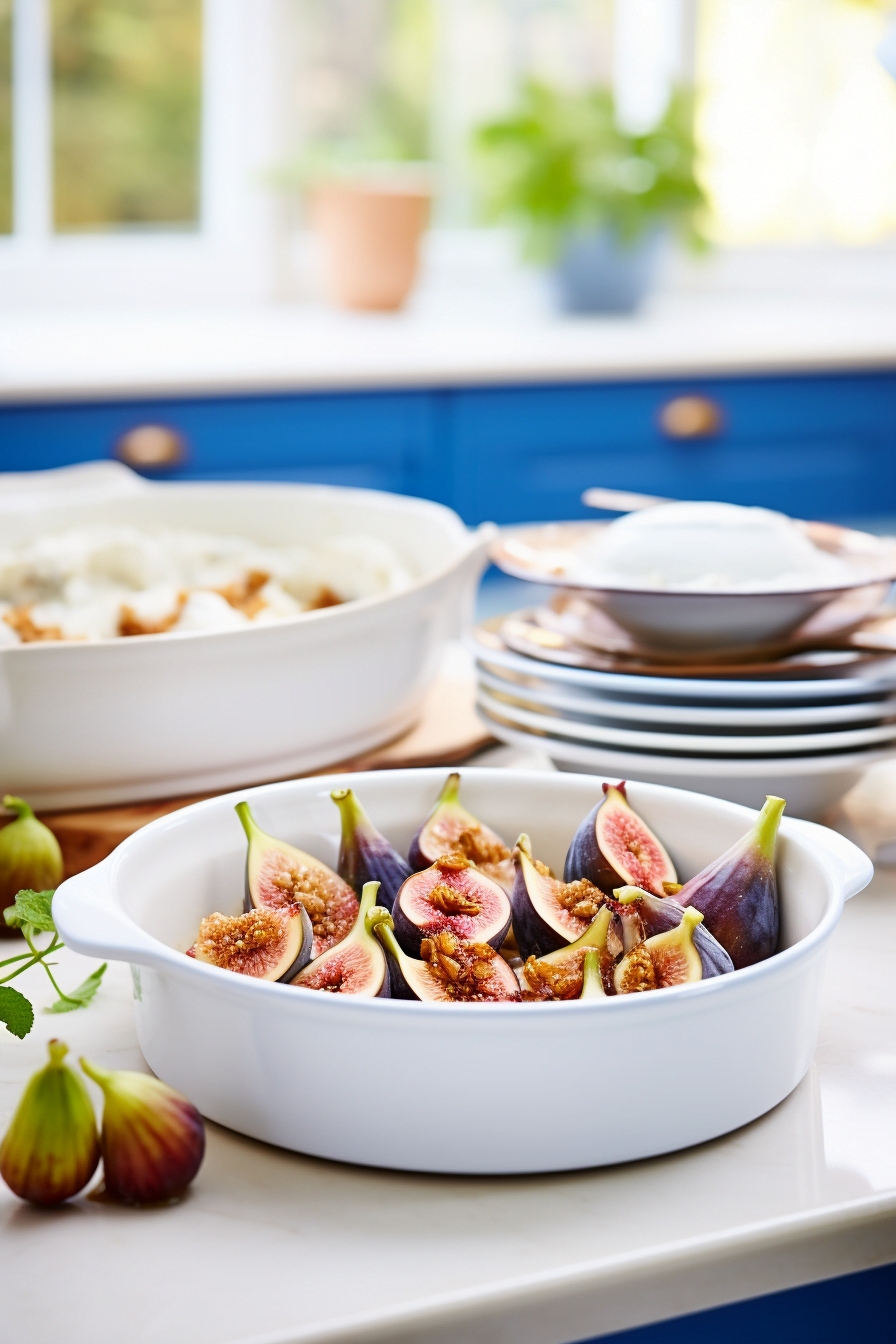
Mastering the Method
Creating this Turkish delight is an exercise in balance and precision. Begin by selecting the ripest figs you can find, as their natural sweetness is paramount to the dish’s success. The figs should be tender but not too soft, as they need to hold their shape during baking.
**Opening the figs** is a delicate process; imagine you’re creating a blossom, ready to hold the flavors you’ll introduce. The drizzle of honey should be done with a light hand, ensuring it permeates the fruit without overwhelming it. As for the **cinnamon**, it’s not just a spice; it’s a bridge between the sweet and creamy elements of the dish.
The **baking time** is crucial; too little, and the figs won’t caramelize, too much, and they’ll lose their texture. Keep a watchful eye as the oven works its magic, transforming the simple ingredients into a symphony of flavors. When it’s time to serve, the kaymak should be generous but not excessive, complementing the figs rather than competing with them.
Remember, this dish is as much about the experience as it is about the taste. The warmth of the figs, the richness of the honey, and the coolness of the kaymak should come together in a harmonious blend that speaks to the soul of Turkish cuisine.
As you perfect your technique, you’ll find that this recipe is more than a set of instructions; it’s a canvas for your culinary expression. Each step is an opportunity to infuse the dish with your personal touch, creating a dessert that’s uniquely yours while still rooted in the traditions of Turkey.
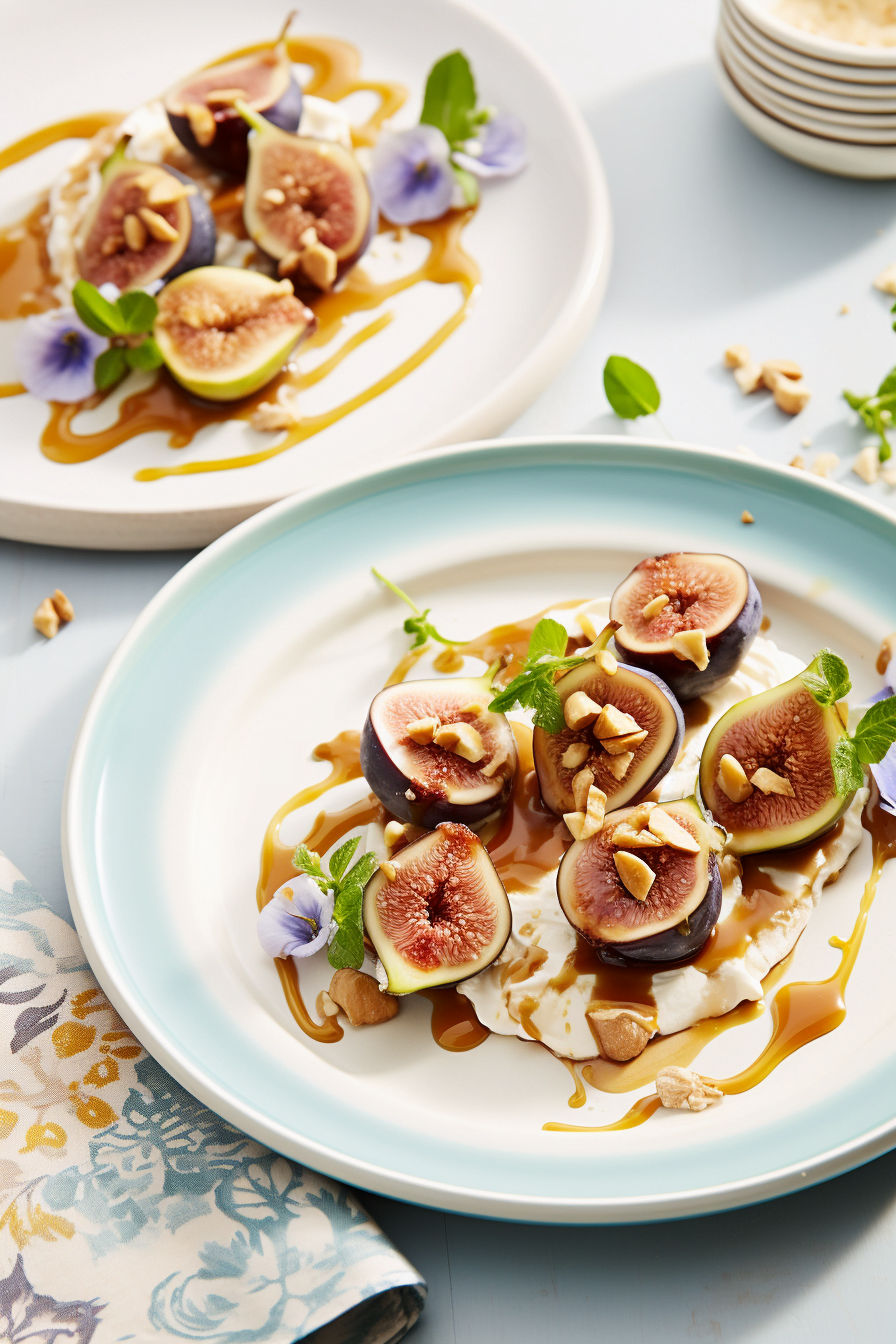
Variations to Explore
With Pistachios and Orange Zest
Enhance the nuttiness by swapping walnuts for pistachios and adding a hint of citrus with fresh orange zest. This combination introduces a new layer of flavor, reminiscent of the diverse influences in Turkish cuisine.
Infused with Rosewater
For a floral twist, lightly sprinkle rosewater over the figs before baking. This subtle addition brings an exotic fragrance that complements the honey’s sweetness and the creaminess of the kaymak.
Spiced with Cardamom
Cardamom, with its unique spicy-sweet profile, can replace cinnamon to offer a different aromatic experience. It pairs beautifully with figs, creating a dessert that’s both comforting and intriguing.
Substitutions for Every Kitchen
While traditional ingredients are preferred, we understand the need for substitutions. If kaymak is unavailable, a thick Greek yogurt or mascarpone can provide a similar creamy texture. For those avoiding honey, maple syrup serves as a fantastic vegan alternative, adding its own rich, earthy sweetness to the dish.
For the nut component, almonds or pecans can stand in for walnuts, each bringing their own distinct flavor and crunch. And while fresh figs are ideal, dried figs, when rehydrated, can also capture the essence of this Turkish classic.
Remember, the spirit of Mediterranean cooking lies in its adaptability and the joy of working with what’s at hand. Don’t hesitate to personalize this recipe with the ingredients you love or have available.
Frequently Asked Questions
Q: Can I use dried figs instead of fresh?
A: Yes, you can use dried figs. Soak them in warm water for a few hours to rehydrate before baking.
Q: Is there a dairy-free alternative to kaymak?
A: Absolutely. Coconut cream can offer a similar texture and a delightful tropical twist.
Q: How do I know when the figs are perfectly baked?
A: The figs should be soft to the touch, and the honey slightly caramelized. Keep an eye on them after 10 minutes in the oven.
Q: Can I prepare this dessert in advance?
A: It’s best enjoyed fresh, but you can bake the figs ahead and add the kaymak just before serving.
Q: What’s the best way to store leftovers?
A: Store in an airtight container in the refrigerator for up to two days. Reheat gently if desired.
Whether you’re a seasoned chef or a curious foodie, this Turkish-Style Baked Figs with Honey and Clotted Cream (Kaymak) recipe is sure to delight. Embrace the simplicity and elegance of Turkish desserts and share this sweet Mediterranean journey with friends and family.
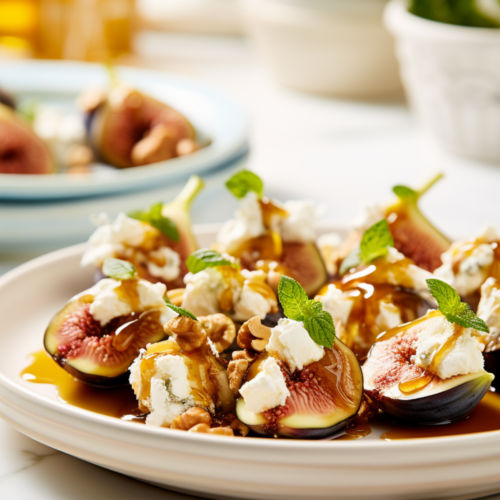
Turkish-Style Baked Figs with Honey and Clotted Cream (Kaymak)
Equipment
- Baking dish
- Knife
- Spoon
Ingredients
- 8 Fresh figs (about 1 lb / 450g)
- 4 tablespoons Honey (60 ml)
- 1 teaspoon Ground cinnamon (2.6g)
- 16 halves Walnut (30g)
- 1 cup Clotted cream (kaymak) (240 ml)
- Fresh mint leaves for garnish optional
Instructions
- Preheat your oven to 350°F (175°C).
- Carefully slice each fig vertically from the top to about halfway down without cutting all the way through. Gently press on the sides to open up the figs like a flower.
- Place the opened figs in a baking dish, ensuring they are not overcrowded.
- Drizzle each fig with honey, making sure some gets inside the cuts.
- Sprinkle the ground cinnamon evenly over the figs.
- Place a walnut half into the center of each fig.
- Bake in the preheated oven for about 15 minutes, or until the figs are soft and slightly caramelized.
- Allow the figs to cool for a couple of minutes before serving.
- Serve two figs per person, topped with a generous dollop of clotted cream (kaymak).
- Garnish with fresh mint leaves if desired.
Notes

